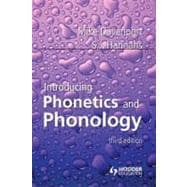
Note: Supplemental materials are not guaranteed with Rental or Used book purchases.
Purchase Benefits
What is included with this book?
| List of tables | p. xi |
| List of figures | p. xiii |
| Preface | p. xv |
| Preface to the second edition | p. xvi |
| Preface to the third edition | p. xvii |
| The International Phonetic Alphabet | p. xviii |
| Introduction | p. 1 |
| Phonetics and phonology | p. 1 |
| The generative enterprise | p. 3 |
| Further reading | p. 6 |
| Introduction to articulatory phonetics | p. 7 |
| Overview | p. 7 |
| Speech sound classification | p. 14 |
| Supra-segraental structure | p. 15 |
| p. 15 | |
| Further reading | p. 16 |
| Exercises | p. 17 |
| Consonants | p. 18 |
| Stops | p. 19 |
| Affricates | p. 26 |
| Fricatives | p. 27 |
| Nasals | p. 30 |
| Liquids | p. 31 |
| Glides | p. 34 |
| An inventory of English consonants | p. 36 |
| Further reading | p. 37 |
| Exercises | p. 37 |
| Vowels | p. 39 |
| Vowel classification | p. 39 |
| The vowel space and Cardinal Vowels | p. 40 |
| Further classifications | p. 42 |
| The vowels of English | p. 43 |
| Some vowel systems of English | p. 52 |
| Further reading | p. 55 |
| Exercises | p. 55 |
| Acoustic phonetics | p. 56 |
| Fundamentals | p. 56 |
| Speech sounds | p. 60 |
| Cross-linguistic values | p. 71 |
| Further reading | p. 71 |
| Exercises | p. 71 |
| Above the segment | p. 73 |
| The syllable | p. 73 |
| Stress | p. 78 |
| Tone and intonation | p. 84 |
| Further reading | p. 89 |
| Exercises | p. 90 |
| Features | p. 91 |
| Segmental composition | p. 91 |
| Phonetic vs. phonological features | p. 92 |
| Charting the features | p. 94 |
| Conclusion | p. 110 |
| Further reading | p. 111 |
| Exercises | p. 113 |
| Phonemic analysis | p. 115 |
| Sounds that are the same but different | p. 115 |
| Finding phonemes and allophones | p. 117 |
| Linking levels: rules | p. 121 |
| Choosing the underlying form | p. 123 |
| Summary | p. 129 |
| Further reading | p. 130 |
| Exercises | p. 130 |
| Phonological alternations, processes and rules | p. 133 |
| Alternations vs. processes vs. rules | p. 133 |
| Alternation types | p. 134 |
| Formal rules and rule writing | p. 138 |
| Overview of phonological operations and rules | p. 143 |
| Summary | p. 145 |
| Further reading | p. 146 |
| Exercises | p. 146 |
| Phonological structure | p. 148 |
| The need for richer phonological representation | p. 149 |
| Segment internal structure: feature geometry, underspecification and unary features | p. 152 |
| Autosegmental phonology | p. 159 |
| p. 166 | |
| Conclusion | p. 174 |
| Further reading | p. 174 |
| Exercises | p. 174 |
| Derivational analysis | p. 176 |
| The aims of analysis | p. 176 |
| A derivational analysis of English noun plural formatio | p. 178 |
| Extrinsic vs. intrinsic rule ordering | p. 182 |
| Evaluating competing analyses: evidence, economy and plausibility | p. 184 |
| Conclusion | p. 194 |
| Further reading | p. 194 |
| Exercises | p. 195 |
| Constraint-based analysis | p. 198 |
| Introduction to optimality theory | p. 198 |
| The aims of analysis | p. 202 |
| Modelling phonological processes in OT | p. 203 |
| English noun plural formation: an OT account | p. 208 |
| Competing analyses | p. 212 |
| Conclusion | p. 215 |
| Further reading | p. 215 |
| Exercises | p. 216 |
| Constraining the model | p. 219 |
| Constraining derivational phonology: abstractness | p. 220 |
| Constraining the power of the phonological component | p. 223 |
| Constraining the power of OT | p. 230 |
| Conclusion | p. 23 |
| Further reading | p. 238 |
| Glossary | p. 239 |
| References | p. 247 |
| Subject index | p. 251 |
| Varieties of English index | p. 256 |
| Language index | p. 257 |
| Table of Contents provided by Ingram. All Rights Reserved. |
The New copy of this book will include any supplemental materials advertised. Please check the title of the book to determine if it should include any access cards, study guides, lab manuals, CDs, etc.
The Used, Rental and eBook copies of this book are not guaranteed to include any supplemental materials. Typically, only the book itself is included. This is true even if the title states it includes any access cards, study guides, lab manuals, CDs, etc.